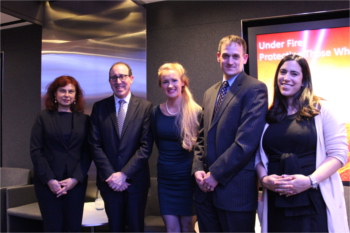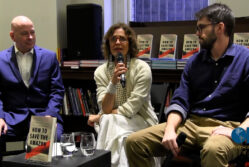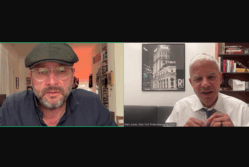Event Coverage Highlight

Journalist Safety Panel Highlights Growing Risks

Left to right: Ambassador Raimonda Murmokaite, Joel Simon, Anna Therese Day, Gregory D. Johnsen and Lara Setrakian. Photo: Chad Bouchard
With violence against journalists soaring to an all-time high in recent years, freelancers and mainstream news media are seeking better ways to protect and give them the support they need to do their jobs.
On Dec. 16, the OPC, Bloomberg LLP and the Ford Motor Company co-sponsored a discussion about journalist safety with a panel of journalists and press freedom advocates.
In 2015, 69 journalists were killed and 199 jailed worldwide, according to the Committee to Protect Journalists.
Joel Simon, the CPJ’s executive director, told attendees that journalists are increasingly targeted because of shifting power in the current “information ecosystem,” with governments, criminal organizations and militant groups becoming less dependent on journalists than they were in the past.
“The reason journalists are more vulnerable is that they no longer exercise this collective information monopoly.” he said. “That feeling of invulnerability you had, that press pass – that magical thing that gave you this sort of force field – that’s gone.”
He called for more pressure from governments, and added that many of the worst jailers of journalists around the world are allies of the U.S.
“They’re countries like Egypt – which is the second leading jailer of journalists – Turkey, Azerbaijan, Saudi Arabia. These are countries where the U.S. has significant influence, and it should be exercising that influence.”
The panel also included Ambassador Raimonda Murmokaite, Lithuania’s permanent representative to the UN. She and Lithuania were the driving force behind a May UN Security Council resolution to scale up efforts to protect journalists in conflict zones. She urged continued pressure on governments that repress free speech. “We have to make noise about this at all possible levels,” she said. “Those who can’t stand the right to free information will never defend the journalists.”
Anna Therese Day, a freelance journalist and a founding board member of the Frontline Freelance Register, applauded work from groups like hers and the alliance of news organizations, freelance reporters and non-profit journalism groups that have crafted the Global Safety Principles and Practices. She said as the industry depends more and more on contracted labor instead of staffers, budgets are “our biggest enemy in terms of freelance safety.”
“Because we can now have this group conversation, we’re able to prove that it’s not impossible to have higher standards,” she said.
Gregory D. Johnsen, who recently left Istanbul where he was writer-at-large for BuzzFeed News, recounted his narrow escape in 2012 from an attempted kidnapping while working in Yemen.
He and a colleague were held at gunpoint on a crowded street, and decided to run – fortunately the kidnappers did not fire and the two escaped. He said to him, the incident signaled a shift after the Arab Spring in the way foreign journalists are seen in the Middle East.
“In Yemen, in Syria, in Iraq, in other places, this has become normal. And when no one knows the rules, no one is willing to step out.”
OPC Governor Lara Setrakian, Co-Founder & CEO of News Deeply, moderated the discussion. In closing remarks, she called for news media companies to shoulder more responsibility.
“I think we’ve seen a lot of major news outlets take a step back and say that we’re going to solve this, so to speak, by not encouraging freelancers or not using their work. And I think it’s a fallacy and it’s completely unfair. Because at the end of the day they still benefit from the passing of that video from one hand to the other.”
Click below to watch clips from the program on the OPC YouTube channel.



